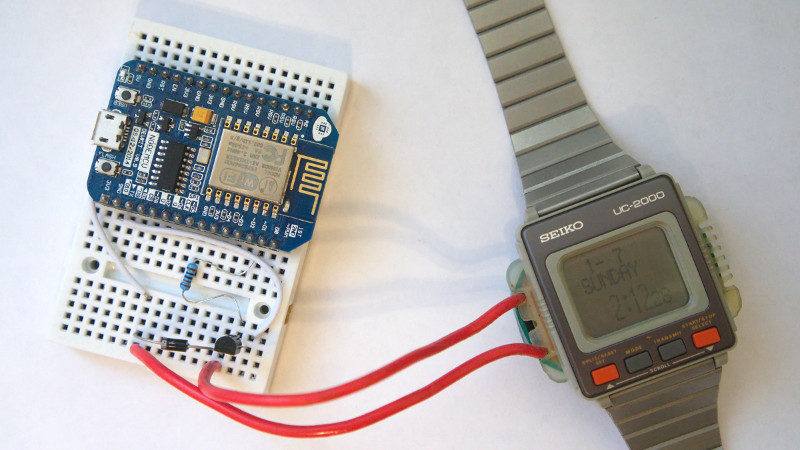While the current generation of smartwatches have only been on the market for a few years, companies have been trying to put a computer on your wrist since as far back as the 80s with varying degrees of success. One such company was Seiko, who in 1984 unveiled the UC-2000: a delightfully antiquated attempt at bridging the gap between wristwatch and personal computer. Featuring a 4-bit CPU, 2 KB of RAM, and 6 KB of ROM, the UC-2000 was closer to a Tamagotchi than its modern day counterparts, but at least it could run BASIC.

Ever since he saw the UC-2000 mentioned online, [Alexander] wanted to get one and try his hand at developing his own software for it. After securing one on eBay, the first challenge was getting it connected up to a modern computer. (Translated from Russian here.) [Alexander] managed to modernize the UC-2000’s novel induction based data transfer mechanism with help from a ATtiny85, which allowed him to get his own code on the watch, all that was left was figuring out how to write it.
With extremely limited published information, and no toolchain, [Alexander] did an incredible job of figuring out the assembly required to interact with the hardware. Along the way he made a number of discoveries which set his plans back, such as the fact that there is no way to directly control individual pixels on the screen; all graphics would have to be done with the built-in symbols.
The culmination of all this hard work? Playing Tetris, naturally. Though [Alexander] admits that limitations of the device’s hardware meant the game had to be simplified a bit, he’s almost certainly having more fun than any of the UC-2000’s original owners did with this device. He’s setup a GitHub repository for anyone who wishes to join him in this brave new world of vintage wrist computing.
[Alexander] isn’t the only one experimenting with fringe wearable computers. We’ve seen our fair share of interesting smartwatches, featuring everything from novel input methods to complete scratch-builds.
















Pointless waste of time…
Excellent hack! :-)
Still got one of these beauties with me. Well done!
You can get a NOS watch and programmer for a mere $1375 on eBay.
https://www.ebay.com/itm/NEW-Vtg-83-NOS-SEIKO-UC2200-wrist-BASIC-programming-LCD-computer-watch-system/263320704204?hash=item3d4f2314cc:g:HEYAAOxyFiRRzny-
But that takes the fun out of it!
I was wondering how they dealt with the problem of getting an adequate keyboard on a watch, and then I found out that they simply used an external keyboard when you wanted to program it.
Simplicity is often the most perfect expression of genius.
Envisioning a wireless charging plate that backs up your phone via nfc whilst it’s charging.
How to stop viruses spreading or someone stealing your data by just bumping into you on the street. Staying indoors with my tinfoil hat no doubt.
I actually had one of these back in the day. It was amazingly cool, but not terribly useful. Wish I could remember what became of it…
Wow- A great read and Kudos to Alexander for getting it all figured out! It put a big smile on my face. Enjoy tetris and keep up the good work :)
Port 3D Monster Maze to it!
https://youtu.be/nKvd0zPfBE4
Install Tetris check, next 3d maze, MAME and Ubuntu! After that, install… [insert favorite huge sw package here]
“there is no way to directly control individual pixels on the screen”
He should try some pokes in that basic.
Yup.
It probably doesn’t have enough RAM to keep a bitmapped image. A lot of early displays stored ASCII characters (or similar) and used a character generator ROM in the hardware path between the video RAM and the screen.
Bingo!
I am really curious what the 4-bit CPU was. I seem to remember a 4-bitter in Kyocera dot matrix printers of that era. It was a 64 pin QIL package.
YFYI: I was making a reference to the C64, which had a similar issue in how it did graphics.
That’s really neat.
I used to mess around with the Timex datalink USB, which had an 8 bit CPU operating at up to 8.2mhz. 48k rom, 2k ram, 32k eeprom, serial I/O. A dot matrix display.
Interestingly, no native floating point support, though some smart coding got around that.
I have one of the originals. Input was via an optical sensor. You ran something on Windows that flashed the CRT to send your outlook alarms. There was a Linux port of the technique. And they had a serial to LED device “for laptops” that worked way better.
There was a community that hacked on it to come up with their own apps.
The data xfer via the monitor didn’t work with LCDs. :(
Makes me want to dig out my “OnHandPC” (aka Ruputer).
http://www.pconhand.com/onhandpc.asp
It actually had quite a few games and utilities. I wrote a program for it to display the time in hex, just to outdo my friend whose watch showed time in binary…